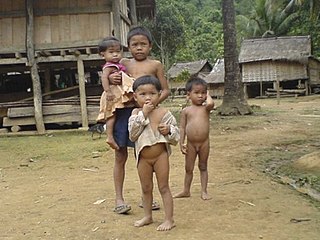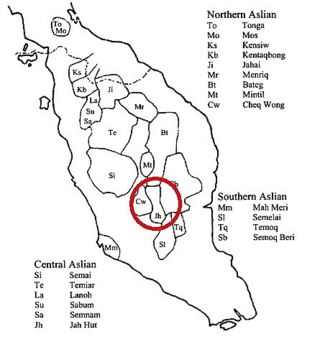
The Austroasiatic languages are a large language family spoken throughout Mainland Southeast Asia, South Asia and East Asia. These languages are natively spoken by the majority of the population in Vietnam and Cambodia, and by minority populations scattered throughout parts of Thailand, Laos, India, Myanmar, Malaysia, Bangladesh, Nepal, and southern China. Approximately 117 million people speak an Austroasiatic language, of which more than two-thirds are Vietnamese speakers. Of the Austroasiatic languages, only Vietnamese, Khmer, and Mon have lengthy, established presences in the historical record. Only two are presently considered to be the national languages of sovereign states: Vietnamese in Vietnam, and Khmer in Cambodia. The Mon language is a recognized indigenous language in Myanmar and Thailand, while the Wa language is a "recognized national language" in the de facto autonomous Wa State within Myanmar. Santali is one of the 22 scheduled languages of India. The remainder of the family's languages are spoken by minority groups and have no official status.

The fifteen Katuic languages form a branch of the Austroasiatic languages spoken by about 1.3 million people in Southeast Asia. People who speak Katuic languages are called the Katuic peoples. Paul Sidwell is the leading specialist on the Katuic languages. He notes that Austroasiatic/Mon–Khmer languages are lexically more similar to Katuic and Bahnaric the closer they are geographically. He says this geographic similarity is independent of which branch of the family each language belongs to. He also says Katuic and Bahnaric do not have any shared innovations, so they do not form a single branch of the Austroasiatic family, but form separate branches.

The Bahnaric languages are a group of about thirty Austroasiatic languages spoken by about 700,000 people in Vietnam, Cambodia, and Laos. Paul Sidwell notes that Austroasiatic/Mon–Khmer languages are lexically more similar to Bahnaric and Katuic languages the closer they are geographically, independently of which branch of the family they belong to, but that Bahnaric and Katuic do not have any shared innovations that would suggest that together they form a branch of the Austroasiatic family, rather forming separate branches.

The nearly thirty Palaungic or Palaung–Wa languages form a branch of the Austroasiatic languages.
The Khmuic languages are a branch of the Austroasiatic languages spoken mostly in northern Laos, as well as in neighboring northern Vietnam and southern Yunnan, China. Khmu is the only widely spoken language in the group.

The Aslian languages are the southernmost branch of Austroasiatic languages spoken on the Malay Peninsula. They are the languages of many of the Orang Asli, the aboriginal inhabitants of the peninsula. The total number of native speakers of Aslian languages is about fifty thousand and all are in danger of extinction. Aslian languages recognized by the Malaysian administration include Kensiu, Kintaq, Jahai, Minriq, Batek, Cheq Wong, Lanoh, Temiar, Semai, Jah Hut, Mah Meri, Semaq Beri, Semelai and Temoq.
The Pakanic languages constitute a branch of two Austroasiatic languages, Bolyu and Bugan. They are spoken in Guangxi and Yunnan provinces of southern China. Mang was formerly included, but is now considered by Paul Sidwell to form its own separate branch within Austroasiatic.

The Senoic languages are a group of Aslian languages spoken by about 33,000 people in the main range of the Malay Peninsula. Languages in the group are: Semai and Temiar, Lanoh, Sabüm, and Semnam.

Khmuic peoples refers to a group of ethnic groups of Southeast Asia.
Oi is an Austroasiatic dialect cluster of Attapeu Province, southern Laos. The dominant variety is Oy proper, with 11,000 speakers who are 80% monolinguals. The Jeng (Cheng) speak the same language but are ethnically distinct. Speakers follow traditional religions.
Pnar, also known as Jaiñtia is an Austroasiatic language spoken in India and Bangladesh.
Proto-Austroasiatic is the reconstructed ancestor of the Austroasiatic languages. Proto-Mon–Khmer has been reconstructed in Harry L. Shorto's Mon–Khmer Comparative Dictionary, while a new Proto-Austroasiatic reconstruction is currently being undertaken by Paul Sidwell.

Jah Hut is an Austroasiatic language spoken around the Krau river in peninsular Malaysia. The Jah Hut are one of the indigenous Orang Asli peoples.
Temiar is a Central Aslian (Mon–Khmer) language spoken in Western Malaysia by the Temiar people. The Temiar are one of the most numerous Aslian-speaking peoples, numbering around 30,000 in 2017.

Cheq Wong is an Austroasiatic language spoken in the Malay Peninsula by the Cheq Wong people. It belongs to the Northern subbranch of the Aslian languages. Northern Aslian was labelled Jehaic in the past.
Ten'edn, also known as Mos in Thailand and Tonga-Mos or just Tonga in some literature, is an aboriginal Mon–Khmer language spoken by the Maniq tribe of Thailand and Malaysia.
Kháng, also known as Mang U’, is an Austroasiatic language of Vietnam. It is closely related to the Bumang language of southern Yunnan, China.
Nyaheun is a Mon–Khmer language of the Bahnaric branch spoken in southern Laos. Chazée (1999:95) estimates the population at 4,200, while the 1995 Laotian census places the Nyaheun population at 5,152. According to Ethnologue, the language is "vigorous," which means it is spoken by people of all ages in its home community.
Sapuan is a Mon–Khmer language spoken in the single village of Ban Sapuan, located approximately 40 km north of Attapeu. Jacq and Sidwell (1999) provide a short grammar. Sidwell (2003) reports a population of just under 1,000. Chazée (1999:93) gives a lower estimate of 480.
Jru' is a Mon–Khmer language of the Bahnaric branch spoken in southern Laos. It is also known as "Loven", "Laven" or "Boloven" from the Laotian exonym Laven or Loven, which is derived from the Khmer name for the Boloven Plateau. The Jru' people engage in coffee and cardamom cultivation, as well as other agricultural activities.






